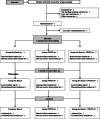Effects of voluntary pre-contraction of the pelvic floor muscles (the Knack) on female stress urinary incontinence-a study protocol for a RCT
- PMID: 34301324
- PMCID: PMC8299632
- DOI: 10.1186/s13063-021-05440-0
Effects of voluntary pre-contraction of the pelvic floor muscles (the Knack) on female stress urinary incontinence-a study protocol for a RCT
Abstract
Background: Stress urinary incontinence (SUI) is a subtype of urinary incontinence that occurs more commonly amongst women. The pelvic floor muscle training (PFMT) is considered the gold standard for treating SUI. Another technique called the Knack postulated that pre-contraction of the pelvic floor muscles (PFM) during activities of increasing intra-abdominal pressure prevents urinary loss. Currently, there are no studies supporting the Knack for the treatment of SUI. Thus, the aim of this study is to test the hypothesis that voluntary pre-contraction of PFM can treat SUI. For this purpose, the following parameters will be analysed and compared amongst (1) the Knack, (2) PFMT and (3) the Knack + PFMT groups: urine leakage as assessed by the pad test, urinary symptoms, muscle function, quality of life, subjective cure, adherence to exercises in the outpatient setting and at home and perceived self-efficacy of PFM exercises.
Methods: A single-centre, double-blind (investigator and outcome assessor) randomised controlled trial with a 3-month follow-up of supervised treatment and an additional 3 months of follow-up (unsupervised) for a total of 6 months of follow-up. Two hundred ten women with mild to moderate SUI will be included, aged between 18 and 70 years. To compare the primary and secondary outcome measures within and between the groups studied (before and after intervention), the ANOVA statistical test will be used. Primary and secondary outcome measures will be presented as mean, standard deviation, 95% confidence interval and median and minimum and maximum values.
Discussion/significance: This study closes a gap, as voluntary PFM pre-contraction (the Knack) has not yet been included in the physiotherapeutic treatment of SUI, and if shown successful could be implemented in clinical practice.
Trial registration: ClinicalTrials.gov NCT03722719 . Registered on October 29, 2018. Study protocol version 1. Was this trial prospectively registered? Yes Funded by: The present study did not receive funding. Anticipated completion date: The anticipated trial commencement and completion dates are October 2018 and October 2021, respectively. Provenance: Not invited. Peer reviewed. Human research ethics approval committee: Research Ethical Board of the Universidade Federal de São Paulo (UNIFESP), Brazil. Human research ethics approval number: 2.517.312.
Keywords: Pelvic floor muscle training; Stress urinary incontinence; The Knack.
© 2021. The Author(s).
Conflict of interest statement
The authors report no conflict of interest.
References
-
- Haylen BT, de Ridder D, Freeman RM, Swift SE, Berghmans B, Lee J, Monga A, Petri E, Rizk DE, Sand PK, Schaer GN. An International Urogynecological Association (IUGA)/International Continence Society (ICS) joint report on the terminology for female pelvic floor dysfunction. Int Urogynecol J. 2010;21(1):5–26. doi: 10.1007/s00192-009-0976-9. - DOI - PubMed
-
- Ko Y, Lin SJ, Salmon JW, Bron MS. The impact of urinary incontinence on quality of life of the elderly. Am J Manag Care. 2005;11(4 Suppl):S103–S111. - PubMed
Publication types
MeSH terms
Associated data
LinkOut - more resources
Full Text Sources
Medical
Miscellaneous


